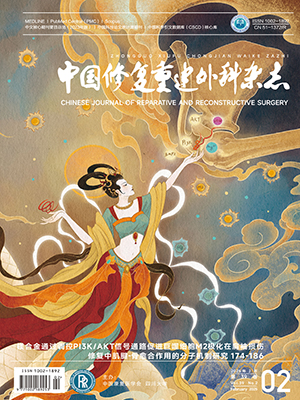| 1. |
Machado GC, Ferreira PH, Harris IA, et al. Effectiveness of surgery for lumbar spinal stenosis: a systematic review and meta-analysis. PLoS One, 2015, 10(3): e0122800.
|
| 2. |
Issack PS, Cunningham ME, Pumberger M, et al. Degenerative lumbar spinal stenosis: evaluation and management. J Am Acad Orthop Surg, 2012, 20(8): 527-535.
|
| 3. |
Harms J, Rolinger H. A one-stager procedure in operative treatment of spondylolistheses: dorsal traction-reposition and anterior fusion (author’s transl). Z Orthop Ihre Grenzgeb, 1982, 120(3): 343-347.
|
| 4. |
张磊, 方向前, 赵兴, 等. 经椎间孔单侧入路双侧减压融合内固定术治疗腰椎管狭窄症的近期疗效观察. 中国修复重建外科杂志, 2017, 31(5): 519-526.
|
| 5. |
Deyo RA, Mirza SK, Martin BI, et al. Trends, major medical complications, and charges associated with surgery for lumbar spinal stenosis in older adults. JAMA, 2010, 303(13): 1259-1265.
|
| 6. |
Foley KT, Holly LT, Schwender JD. Minimally invasive lumbar fusion. Spine (Phila Pa 1976), 2003, 28(15 Suppl): S26-S35.
|
| 7. |
Wang J, Zhou Y, Zhang ZF, et al. Comparison of one-level minimally invasive and open transforaminal lumbar interbody fusion in degenerative and isthmic spondylolisthesis grades 1 and 2. Eur Spine J, 2010, 19(10): 1780-1784.
|
| 8. |
漆启华, 肖强, 邓亮, 等. 旁正中切口微创与开放经椎间孔腰椎椎体间融合术治疗单节段腰椎退行性疾病的疗效比较. 中国修复重建外科杂志, 2015, 29(10): 1253-1258.
|
| 9. |
Schizas C, Theumann N, Burn A, et al. Qualitative grading of severity of lumbar spinal stenosis based on the morphology of the dural sac on magnetic resonance images. Spine (Phila Pa 1976), 2010, 35(21): 1919-1924.
|
| 10. |
Wang J, Zhou Y, Zhang ZF, et al. Minimally invasive or open transforaminal lumbar interbody fusion as revision surgery for patients previously treated by open discectomy and decompression of the lumbar spine. Eur Spine J, 2011, 20(4): 623-628.
|
| 11. |
Ogon M, Krismer M, Söllner W, et al. Chronic low back pain measurement with visual analogue scales in different settings. Pain, 1996, 64(3): 425-428.
|
| 12. |
Fairbank JC, Pynsent PB. The Oswestry Disability Index. Spine (Phila Pa 1976), 2000, 25(22): 2940-2952.
|
| 13. |
Bridwell KH, Lenke LG, McEnery KW, et al. Anterior fresh frozen structural allografts in the thoracic and lumbar spine. Do they work if combined with posterior fusion and instrumentation in adult patients with kyphosis or anterior column defects? Spine (Phila Pa 1976), 1995, 20(12): 1410-1418.
|
| 14. |
Genevay S, Atlas SJ. Lumbar spinal stenosis. Best Pract Res Clin Rheumatol, 2010, 24(2): 253-265.
|
| 15. |
Ishimoto Y, Yoshimura N, Muraki S, et al. Prevalence of symptomatic lumbar spinal stenosis and its association with physical performance in a population-based cohort in Japan: the Wakayama Spine Study. Osteoarthritis Cartilage, 2012, 20(10): 1103-1108.
|
| 16. |
Weinstein JN, Tosteson TD, Lurie JD, et al. Surgical versus non-operative treatment for lumbar spinal stenosis four-year results of the spine patient outcomes research trial (SPORT). Spine (Phila Pa 1976), 2010, 35(14): 1329-1338.
|
| 17. |
郑扬, 李危石, 陈仲强, 等. 微创与开放经椎间孔椎体间融合术治疗腰椎单节段退行性疾病的临床疗效比较. 中国脊柱脊髓杂志, 2014, 24(12): 1064-1071.
|
| 18. |
Peng CW, Yue WM, Poh SY, et al. Clinical and radiological outcomes of minimally invasive versus open transforaminal lumbar interbody fusion. Spine (Phila Pa 1976), 2009, 34(13): 1385-1389.
|
| 19. |
杨进, 孔清泉, 宋跃明, 等. 微创小切口与开放经椎间孔腰椎椎间融合术治疗单节段腰椎退变疾患的近期疗效比较. 中国修复重建外科杂志, 2013, 27(3): 262-267.
|
| 20. |
Li XC, Huang CM, Zhong CF, et al. Minimally invasive procedure reduces adjacent segment degeneration and disease: New benefit-based global meta-analysis. PLoS One, 2017, 12(2): e0171546.
|
| 21. |
Wang J, Zhou Y. Perioperative complications related to minimally invasive transforaminal lumbar fusion: evaluation of 204 operations on lumbar instability at single center. Spine J, 2014, 14(9): 2078-2084.
|




